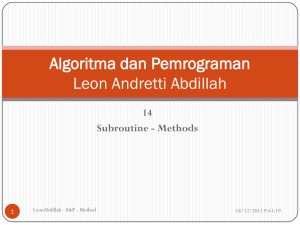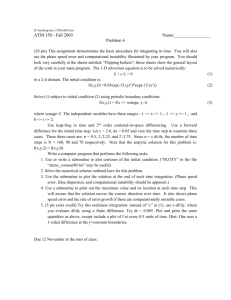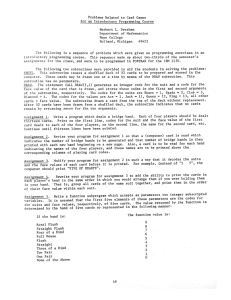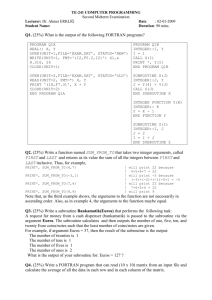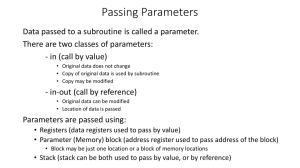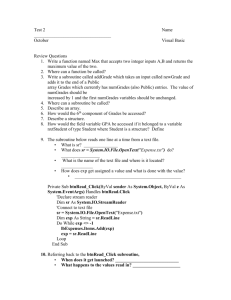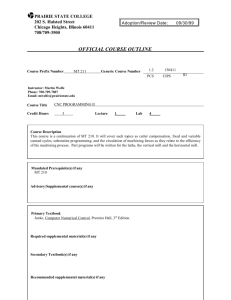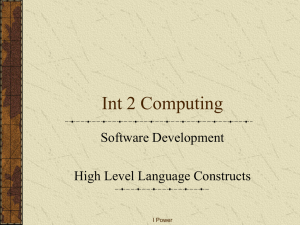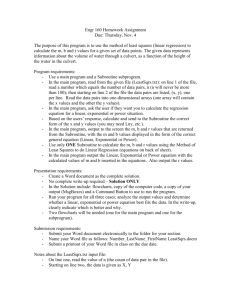Research Staff Elaine C. Isaacs
advertisement
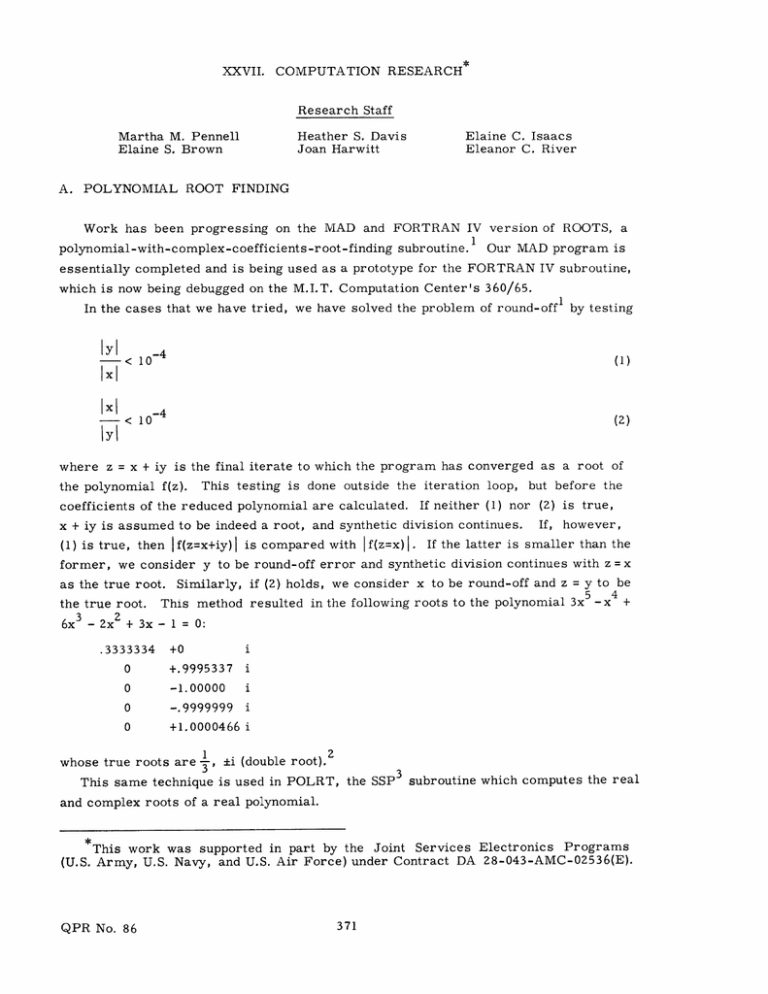
XXVII.
COMPUTATION RESEARCH
Research Staff
Heather S. Davis
Joan Harwitt
Martha M. Pennell
Elaine S. Brown
A.
Elaine C. Isaacs
Eleanor C. River
POLYNOMIAL ROOT FINDING
Work has been progressing on the MAD and FORTRAN IV version of ROOTS, a
polynomial-with-complex-coefficients-root-finding subroutine.
Our MAD program is
essentially completed and is being used as a prototype for the FORTRAN IV subroutine,
which is now being debugged on the M.I.T. Computation Center's 360/65.
In the cases that we have tried, we have solved the problem of round-offl by testing
-
< 10 -
4
(1)
Ixl
X
1-
lyl
< 10
-4
(2)
where z = x + iy is the final iterate to which the program has converged as a root of
the polynomial f(z). This testing is done outside the iteration loop, but before the
coefficients of the reduced polynomial are calculated. If neither (1) nor (2) is true,
x + iy is assumed to be indeed a root, and synthetic division continues. If, however,
(1) is true, then If(z=x+iy)l is compared with If(z=x) . If the latter is smaller than the
former, we consider y to be round-off error and synthetic division continues with z = x
as the true root. Similarly, if (2) holds, we consider x to be round-off and z = y to be
4
5
the true root. This method resulted in the following roots to the polynomial 3x -x +
6x 3 - 2x 2 + 3x - 1 = 0:
+0
i
0
0
+.9995337
-1.00000
i
0
-.9999999
.3333334
0
i
i
+1.0000466 i
1
whose true roots are 3,
±i (double root).
2
This same technique is used in POLRT, the SSP
subroutine which computes the real
and complex roots of a real polynomial.
*This work was supported in part by the Joint Services Electronics Programs
(U.S. Army, U.S. Navy, and U.S. Air Force) under Contract DA 28-043-AMC-02536(E).
QPR No. 86
371
(XXVII.
COMPUTATION RESEARCH)
The program uses the Newton-Raphson technique, which involves no root taking and
consequently must always start with an initial complex guess to find a complex answer.
POLRT fails after no convergence with 500 iterations on the 5 starting values:
-. 1000101
-. 0500101
.500101
1.000101
-10.00101
50.00101
-1000.101
-5.00101
100.0101
-500.0101.
We found that POLRT failed on the following polynomial
3x
35
- 4x 5 + 1 = 0,
30 of whose roots are known to lie within the unit circle,
and none are double roots.
POLRT succeeded, however, when the polynomial was divided through by the obvious
root x = 1, and also succeeeded when the substitution
y=x
5
resulted in the following polynomial:
3y7 -_ 4y + 1 = 0.
We are planning to study the relative merits of both methods.
Martha M. Pennell, Joan Harwitt
References
1.
Martha M. Pennell and Joan Harwitt, "Roots, a Root-finding Subroutine Using
Muller's Method," Quarterly Progress Report No. 84, Research Laboratory of Electronics, M.I.T., January 15, 1967, pp. 352-354.
2. Ibid., see Eq. 1, p. 353.
3.
"System/360 Scientific Subroutine Package (360A-CM-03X) H20-0166-1," IBM Applications Program, n. d., pp. 84-85.
B.
MODIFICATION OF THE IBM SCIENTIFIC PACKAGE FOR GENERAL USE
A basic problem in the IBM Scientific Package for os/360 is dimensioning of twodimensional arrays. The manual states that in the main program "If the matrix is smaller
than the dimensioned area, the two forms of storage are not compatible." 1 For example, if
a matrix is dimensioned A(50, 50)and the amount to be used is only A(25,5) or A(25,25) the
QPR No. 86
372
Example 2
Example 1
Original
Original
Main Program
Main Program
Dimension A(25, 5)
Dimension A(25, 5)
CALL PLOT (NO, A, N, M, NL, NS) 2
CALL SIMQ(A, B, N, KS)
Subroutine
Subroutine
Subroutine Plot (NO, A, N, M, NL, NS)
Subroutine Simq(A, B, N, KS)
Dimension A(1)
Dimension A(l), B(1)
rrI
After Change
After Change
Main Program
Main Program
Dimension B(50, 50)
Dimension A(50, 50)
K= 50
M= 50
CALL PLOT (NO,B,N,M,NL,NS,K)
CALL SIMQ(A, B, N, KS, M)
Subroutine
Subroutine
Subroutine Plot (NO, B, N, M, NL, NS, K)
Subroutine Simq(A, B, N, KS, M)
Dimension B(K, K), A(5000)
Dimension A(M, M) B(1)
I= 1
DO 39
J= 1,M
DO 39
K= 1,N
A(I) = B(K, J)
I=I+1
39 Continue
II
QPR No. 86
373
(XXVII.
COMPUTATION
RESEARCH)
routines will not work. An obvious approach is to dimension the matrix exactly, but in
some cases in which the matrix size varies within the program, this is not feasible.
Two methods have been used to correct this problem.
In both cases the subroutine
has been altered and one argument added to the calling sequence.
This extra argument,
tacked on at the end of the call, is the number of rows and columns in the dimensional
matrix; it would be 50 in the example above.
The restriction that the matrix be square
is used to decrease the complexity of reprogramming.
The dimensions for the portion
of the matrix actually used are already included in the calling statement as arguments.
In the easier method, Example 1, the name of the matrix in the main program is
changed from A to B.
The change must also be carried through in the subroutine. Since
the two-dimensional matrix B(50, 50) is now being brought through the calling sequence,
it must be dimensioned as such in the subroutine. A no longer comes through the calling
sequence,
so it must be dimensioned as large as it could possibly be in the subroutine.
Once this is done, a loop is used to place the portion of the B matrix that is to be used in
the A vector.
Since the program was originally written to use the vector A and all pertinent information is now in A, the subroutine may safely be used from this point on as
it was.
In the second method, Example 2, the name of the matrix in the main program is
not changed, but the dimension statement in the subroutine must be changed, since A is
now brought through as a two-dimensional matrix.
Once this is done, the indexing of A
must be changed throughout the subroutine, and A treated as a two-dimensional matrix
rather than a vector.
This is a tricky procedure in most subroutines and there is
less
chance of error if the first method is used.
Our group is using both methods to alter subroutines from the IBM Scientific Package and has modified decks for SIMQ and PLOT available for general distribution.
Joan Harwitt
References
1.
"System/360 Scientific Subroutine Package (360A-CM-03X),
grammer's Manual, n. d., p. 4.
2.
Ibid.,
p. 298
3.
Ibid.,
p. 178.
C.
CONFLUENT HYPERGEOMETRIC
Version II," IBM Pro-
FUNCTION
Recently, we were presented with a request to evaluate the confluent hypergeometric
function which has numerous applications in various branches of physics.
We were surprised to discover the paucity of published material on this topic. One
of the more complete tables 1 of the confluent hypergeometric function, published in 1948,
QPR No. 86
374
(XXVII.
COMPUTATION RESEARCH)
was done by the Joint Computing Group of the Research Laboratory of Electronics.
Miss Elizabeth Campbell informs us that the evaluation of the confluent hypergeometric function had been, in 1948, a fairly large project. At that time, all calculations
were done by hand; all figures were carried on a 10-bank desk calculator.
Several people were involved in the work of evaluating this function. Indeed, they
for
spent a great deal of time finding ways to reduce the number of calculations needed
each set of values. Miss Campbell further estimated that to do all of the work would
have taken one person an entire summer.
Today, the entire problem forms a rather short job. Using the series representation for the function
a(a+l) 2 +
+ "''
Z
M(a;y;z) = 1 + az +
Y
y(y+l)
2
F(a +n) z n
IF(y)
=
n=0 r(a) F(y+n) n!
we found that the Fortran IV program to evaluate the confluent hypergeometric function
took one person approximately 10 hours to write and debug.
The actual computer time needed to run the program was negligible. We used 191
values of a, y, and z to test the accuracy of the program. Convergence occurred in a
minimum of 3 steps for small values of a and z, y being held constant, and in a maximum of 21 steps for larger values of a and z, -y again being held constant.
The program was run at the Computation Center, M.I.T., on the IBM 360/65. Compilation and run time for the program was 1min and 14.26 sec.
Admittedly, the existence of the earlier evaluation of the function simplified our
check of the program. We plan to investigate further, however, the relative accuracy
of man versus computer.
Elaine C. Isaacs
References
1.
A. D. MacDonald, "Properties of the Confluent Hypergeometric Function," Technical Report 84, Research Laboratory of Electronics, M.I.T., November 18, 1948.
D.
REPLACEMENT OF INFINITE LIMITS OF INTEGRATION BY FINITE ONES AN ILLUSTRATION
We wish to integrate the function
re-r
E =
0
QPR No. 86
0
(2
IZr
ey
dy
)e
y x
0
375
dr
(XXVII.
COMPUTATION RESEARCH)
=
re-r
L(r, y) dy/(1+p)
0
for a given
0
a- , X, and p, where I is an I-Bessel function, and a , X, p > 0.
We do the integration numerically by evaluation of
N
A =
re
O
r
2
OM(r)
L(r, y) dy p/(l+p) dr,
0
where N and M(r) are chosen to make IE-AI < E for an arbitrary E.
We shall show that we can find N and M(r) such that
2 FOcc
P =
re
-
p/(
y
1+
p)
L(r, y) dy
dr < 22
0
and
p/(1+p)
R
re
-
2
dr <
00(r) L(r, y) dy
E -A I < . (Note that the functions re - r and L(r, y) are always
and y are positive, so that absolute value signs are unnecessary.)
It then follows that
positive when r
We first approximate L(r, y) as follows.
o(x) =
n=O0
x 2n
22n(n!)2
By definition,
"
By Stirling's formula,
(n!) -- e - n
2
2n
(n!)
2
2rn
-2n
2n
2Tn
(2n)
e
-2n
2n
2
Therefore (2n)!
22n(n)2
Therefore (2n)! < 2n (n!)
oo
Io(x
)=
QPR No. 86
2n
and
2
and
o9
x
2 2n(n!)2
n=O
n=0n=0
n=
2
n
cc
x
(Zn)!
n
x
n=0
376
= ex
(XXVII.
< er
I (2r Ny)
Consequently,
COMPUTATION RESEARCH)
1y)
-(ln y)Z/2Z-2
To estimate B(y) =
, we note that it is > 0 on the interval [0, oo) and
yo-x
-(ln y)'/2-T '
dB(y)
-ln y
e-
x).
-
2 2
dy
It must therefore have a maximum on [0, oa).
oo;
0 and as y -
approaches zero as y -
x
Y av
2
-Ox
dB(y)
So dy
0 when y= e
Therefore, letting
cr2/2
e
MAX = B (e"
0x
we have B(y) < MAX on [0, co),.
We now have
2
L(r, y) <e
y) . MAX = MAX
. e(2r"-
X y - r )2
e- ( F
e
r2
Therefore
P ~rer 2
Sr-r
N
Lo
< (MAX)p/(1
p/(l+p)
0
p /( +
L(r, y) dy
+p)
LK
rer
y-r)
e-(
e 2_dy p/(1+p)
0
N
Letting z = N-y - r,
)
we get
dz = N'J dy;
Z yp/(i+p)
re
Q = (MAX)p/(1+p)
oo
e -z
r
L
2
-r
2
e-
Since
N
-
z
dy = q7,
-00o
QPR No. 86
377
dyj
dr.
dr = Q.
(XXVII. COMPUTATION RESEARCH)
p/(l+p)
Q <(MAX
(l+p)
00
I
(
+p]) dr
P / ( +IP )
''
-N2/(1+p)
2MAX-
=
l
re(-r 2 /[
N
It is clear then that for a given E > 0, we can choose N so large that
P <
p/('+p) -N2/(1+P)
'
(1+p)
MAX -
E
2<
We have defined R as follows:
d
/(1+p)
L(r, y)
R =
re
- r
) L(r, y) dy]
dr.
r)
Hence,
2F
R < (MX)
R< -
P/(P)
0
re-r
2
Z2
oo
e-
e
(I
p/ ( + p )
z
dr = S.
M(r)-r)
Now we can choose a fixed M > 1 such that
o
2
r2
-r
S = (l~)P/(1+P)
00
2
]p/(l+p)
dz
dr <- 2'
(
This follows, since for M
e
So
M
-z
dz <
> 1,
0
M
-z
2
dz -
e
-M 2o
2M
.
0
M 2 P/(1+p)
S
SM0
1< MAX e
2M/
NK
(
2
re[-r /(1+p)]
0
-M2
e
o
dr=(MAX
NIT- 2M o
/(l+p)
l+p
2
and it is clear that this last quantity can be made arbitrarily small by an appropriate
M +r
choice of M
Now if for each r in the range [0, N] we let M(r) =o
QPR No. 86
378
NTx
, then
(XXVII.
=
S MAXP/(1+P)
S
S
0
M(
re-r [er2
(
COMPUTATION RESEARCH)
/(+p)
-z
e-
d
M(r) -r)
dr = SM
0
since M o = ,4"M(r) - r.
Therefore R < S < E, and we have established that IE - Al < E.
The problem is now in a form that is suitable for the application of numerical quadrature techniques requiring finite limits.
Elaine S. Brown
QPR No. 86
379
